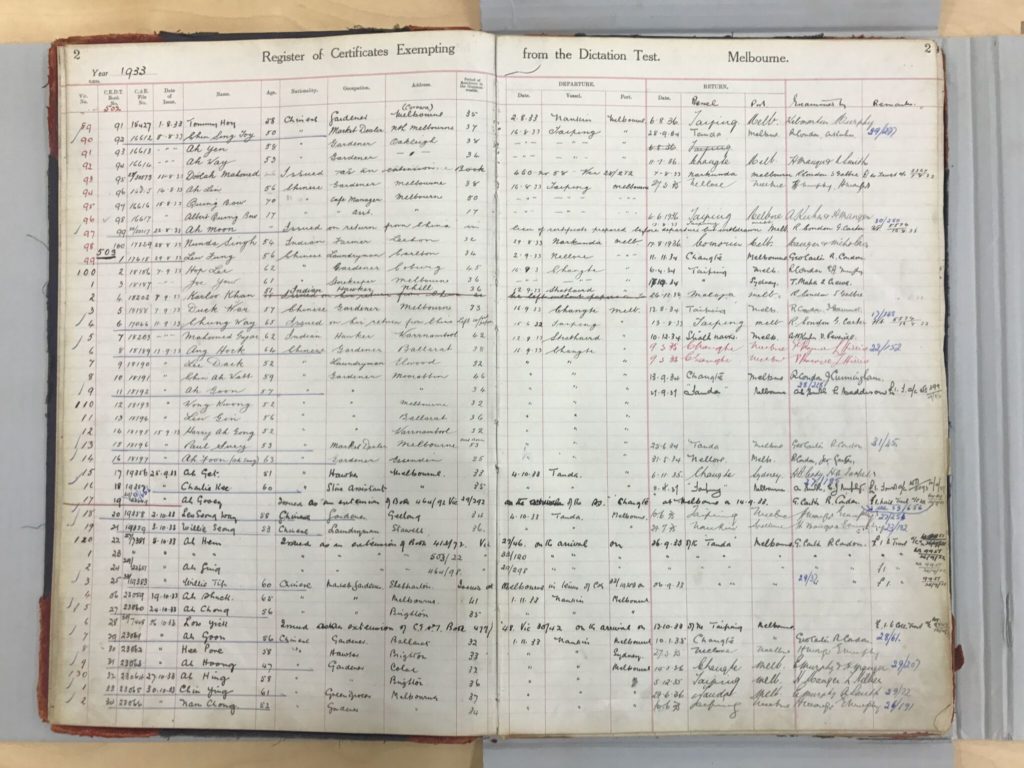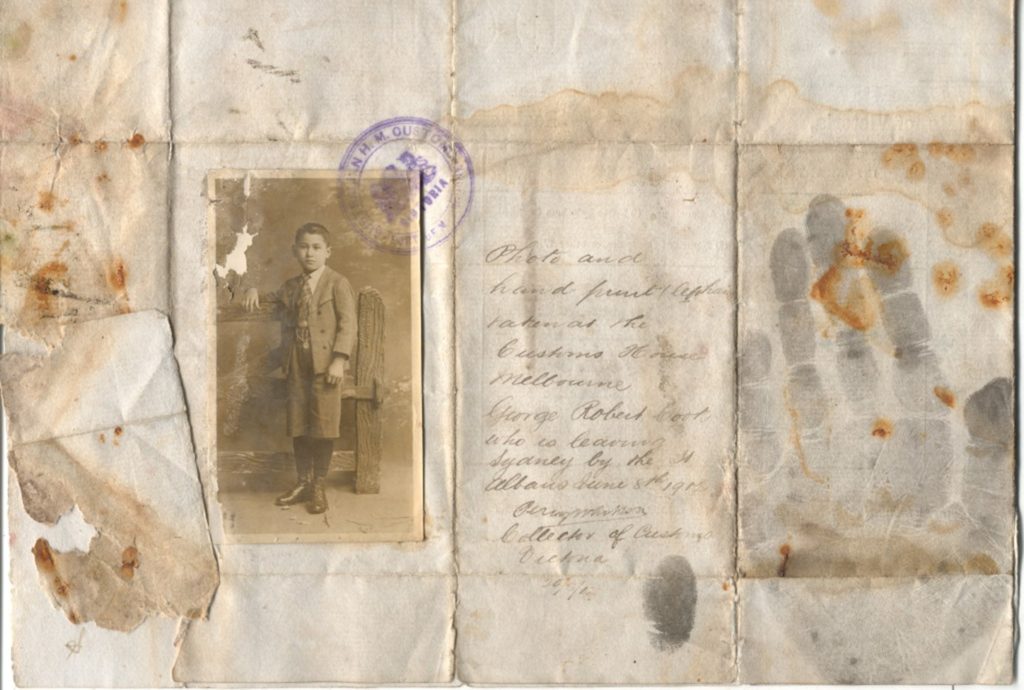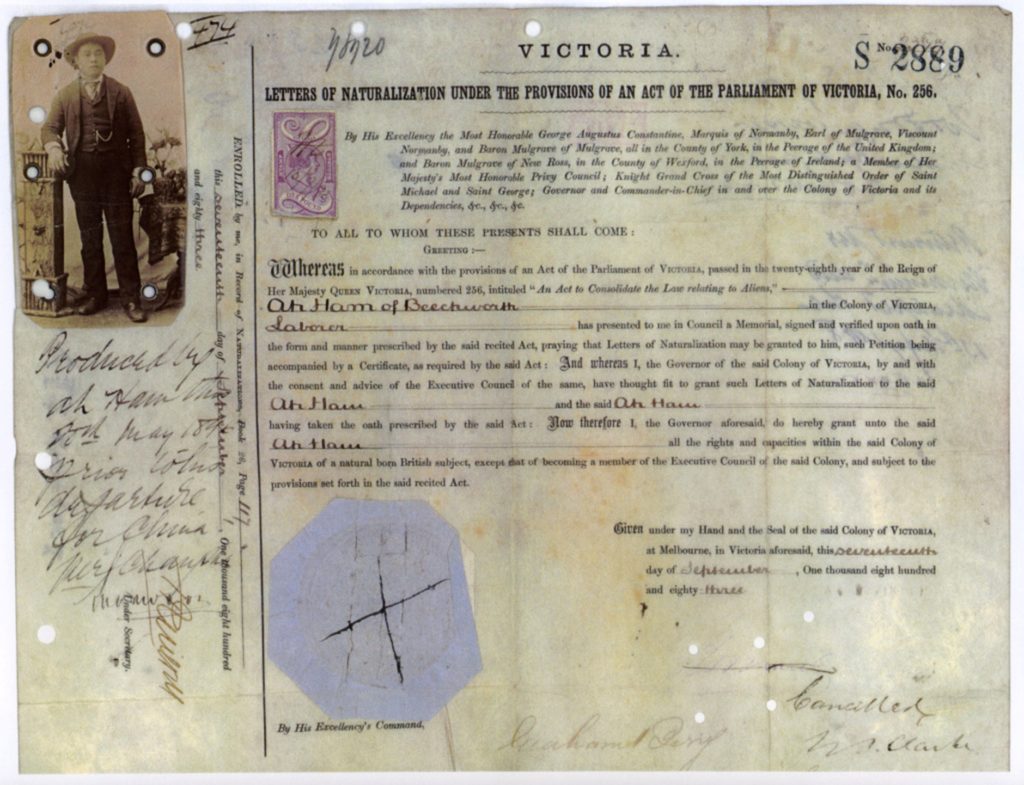This site provides an online searchable index to three registers of applications for Certificates Exempting from Dictation Test (CEDT) made in Victoria between 1904 and 1959. It allows you to track the overseas travel of long-term ‘coloured’ residents of Australia over this period. Not everyone travelled, not everyone travelled on a CEDT but this database offers an extraordinary insight into the settlement and mobility of those who did.
The registers capture around 13,000 journeys made between 1904 and 1959. The blogposts provide inspiration about how the information in these registers can be used and understood.
You can view digital photographs of the Register online via the Victorian CEDT Index or you can order and examine the originals from the National Archives of Australia and view them at the Victorian Archives Centre Reading Room in North Melbourne.
The Victorian CEDT Index was developed by the Chinese Australia Family Historians of Victoria Inc with funding from a Victorian Local History Grant in 2020-2021. Content was keyed by CAFHOV members and members of the public as part of an earlier crowd-sourced project developed by CAFHOV.
What are these Victorian CEDT registers?
These registers were created as part of administering the Federal Government Immigration Restriction Act 1901 (colloquially called the ‘White Australia Policy’) which operated from 1901 until it was repealed in June 1959. Under the Act anyone could be declared a ‘prohibited immigrant’ and denied entry to Australia if they failed to pass a dictation test set by authorities.
While in theory the test could be given to anyone, in practice authorities were instructed to only administer the test to ‘coloured’ arrivals. The test itself was designed to be failed and could be set in any European language. If, however, you had a Certificate Exempting from Dictation Test or CEDT you could freely re-enter Australia. These registers document information about those who applied for these CEDTs.

Who applied for CEDTs?
CEDTs were granted to people who today we might describe as permanent residents. You were eligible for a CEDT if you were a ‘coloured’ immigrant who had lived lawfully in Australia for five years or more and had made Australia your home. A CEDT allowed you to return to Australia after a stay away of up to three years, without having to sit the dictation test.
If you wanted to stay overseas longer than three years, it was possible to extend your CEDT but you did need to pay an administration fee for a new CEDT every time you wanted to travel or extend your travel.
If you were born or naturalized in Australia you were legally entitled to re-enter Australia, however as the dictation test was set at the discretion of customs officials, you also had to prove your identity to the satisfaction of authorities. From the mid-1880s most colonies of Australia prevented Chinese from being naturalized – in Victoria this was done by administrative decision, the government simply did not approve any further Chinese naturalizations. In 1903 the Federal Government’s Naturalization Act turned this into a legislative bar and it extended the deny naturalization to anyone who was ‘an aboriginal native of Asia, Africa, or the Islands of the Pacific, excepting New Zealand’.
Some Chinese Australians added photographs to their birth and naturalization certificates to assist with identification because birth certificates and naturalization certificates only had the person’s name and no physical descriptions or other way of confirming that the holder of the certificate was the person named on it.
Others, despite not technically needing to, chose to apply and pay for a CEDT – perhaps not understanding the system but more likely because it made identification on returning to Australia easier. This means you will also sometimes find the names of people who did not require a CEDT listed in the CEDT registers (for more information see Born in Australia but travelling on a CEDT? The O’Hoy and Tong families.


There are also some people who travelled overseas who you might expect to have a CEDT who are not listed in the registers. It is worth checking to see whether they applied for a CEDT in a different State or Territory. It was also possible to travel on an official government letter rather than a CEDT.
What do the CEDT Registers contain?
Victorian CEDT registers helped officials track CEDT applications and certificates and the movement of CEDT holders over time. They were just one part of an extensive national system used to administer the Immigration Restriction Act.
While the system was Federally controlled each State had their own slightly different administrative processes. Not all of the documentation related to these processes survives and different material from the different systems survives in different States (Kate Bagnall, Collecting CEDT applications and certificates, Tiger’s Mouth Blog).
The three registers indexed in this project contain information about CEDTs granted between 1904 and 1959. If a register was kept for CEDTs granted between 1902 and 1903 this does not seem to have survived.
The first register is a repurposed register in which handwritten headings replace those at the top of the page. As can be seen in the table below the first register provides slightly less information than the later registers. The second two were printed to purpose. In addition to separating out some of the information provided in Register 1 into separate fields they also included two additional administrative numbers – CEDT Book Number and C&E File Number.
Comparison of information provided in the three CEDT Registers
| REGISTER 1 FIELDS | REGISTER 2 and 3 FIELDS |
| No (Number) | Vic No. |
| CEDT Book No. | |
| C&E File No. | |
| Date of Issue | |
| Name | Name |
| Age | Age |
| Nation/Nationality | Nationality |
| Occupation | Occupation |
| Residence | Address |
| Period of Residence yrs/Period in Commonwealth | Period of Residence in the Commonwealth |
| Date of Departure (later dates ticks used, no date) | Departure – Date |
| Departure – Vessel | |
| Departure – Port | |
| Date of Return/Date of Departure and Boat | Return – Date |
| Return – Vessel | |
| Return – Port | |
| Officers Examining on Return/Examined by | |
| Remarks/C&E number, Ship returned, Date returned | Remarks |
Acknowledgements
Transcription Team 2019
- Sophie Couchman
- Andrew Wong – Web Developer (Transcription site)
- Alan To
- Terry Young
- Jonathan O’Donnell
Vic CEDT Index Team 2021
- Terry Young – Project Manager (Help/Visualisations)
- Luke Young – Web Developer (Search)
- Sophie Couchman – Historian, Writer, Consultant (About/Stories/FAQ)
- Kristy Love – Marketing/Promotion
Transcribers 2019
- 44 volunteer transcribers who worked at the Chinese Museum and online
Focus Group 2020
- Kate Bagnall (University of Tasmania)
- Jenny Coates (RHSV)
- Ann Copeland (State Library of Victoria)
- Mark Hillyer (CAFHOV)
- Irene Poon (CAFHOV)
- Ethel Villafranca (Museum of Chinese Australian History)
Data Verification Team 2021
- Louis Chan
- John and Ming Griffiths
- Sally Keam
- Irene Poon
- Laraine Ramsey
- Anna Wolf
- Len Kenna and Crystal Jordan (Indian Australian names)
- Maya Kanomori (Japanese Australian names)
Database User Testers 2021
- Diane Gillespie
- Marie Hammond
- Mark Hillyer
- Kristy Love
- Irene Poon
- Ann Thorogood
Photographs of the Victorian CEDT Registers were taken by CAFHOV with the kind permission of the National Archives of Australia.
A special thank you to the Chinese Museum for their support of CAFHOV by providing us with a venue in which we can meet and share ideas and research.
CAFHOV gratefully acknowledges the support of the Victorian Government and Public Record Office Victoria for making this project possible.

